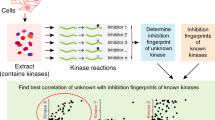Abstract
Phosphorylation by protein kinases is the most widespread and well-studied signaling mechanism in eukaryotic cells. Phosphorylation can regulate almost every property of a protein and is involved in all fundamental cellular processes. Cataloging and understanding protein phosphorylation is no easy task: many kinases may be expressed in a cell, and one-third of all intracellular proteins may be phosphorylated, representing as many as 20,000 distinct phosphoprotein states. Defining the kinase complement of the human genome, the kinome, has provided an excellent starting point for understanding the scale of the problem. The kinome consists of 518 kinases, and every active protein kinase phosphorylates a distinct set of substrates in a regulated manner. Deciphering the complex network of phosphorylation-based signaling is necessary for a thorough and therapeutically applicable understanding of the functioning of a cell in physiological and pathological states. We review contemporary techniques for identifying physiological substrates of the protein kinases and studying phosphorylation in living cells.
This is a preview of subscription content, access via your institution
Access options
Subscribe to this journal
Receive 12 print issues and online access
$259.00 per year
only $21.58 per issue
Buy this article
- Purchase on Springer Link
- Instant access to full article PDF
Prices may be subject to local taxes which are calculated during checkout

Similar content being viewed by others
References
Hunter, T. Signaling–2000 and beyond. Cell 100, 113–127 (2000).
Knebel, A., Morrice, N. & Cohen, P. A novel method to identify protein kinase substrates: eEF2 kinase is phosphorylated and inhibited by SAPK4/p38delta. EMBO J. 20, 4360–4369 (2001).
Fukunaga, R. & Hunter, T. Identification of MAPK substrates by expression screening with solid-phase phosphorylation. Methods Mol. Biol. 250, 211–236 (2004).
Lock, P., Abram, C.L., Gibson, T. & Courtneidge, S.A. A new method for isolating tyrosine kinase substrates used to identify fish, an SH3 and PX domain-containing protein, and Src substrate. EMBO J. 17, 4346–4357 (1998).
Cujec, T.P., Medeiros, P.F., Hammond, P., Rise, C. & Kreider, B.L. Selection of v-abl tyrosine kinase substrate sequences from randomized peptide and cellular proteomic libraries using mRNA display. Chem. Biol. 9, 253–264 (2002).
Zhu, H. et al. Analysis of yeast protein kinases using protein chips. Nat. Genet. 26, 283–289 (2000).
Reimer, U., Reineke, U. & Schneider-Mergener, J. Peptide arrays: from macro to micro. Curr. Opin. Biotechnol. 13, 315–320 (2002).
Rychlewski, L., Kschischo, M., Dong, L., Schutkowski, M. & Reimer, U. Target specificity analysis of the Abl kinase using peptide microarray data. J. Mol. Biol. 336, 307–311 (2004).
Zhu, H. et al. Global analysis of protein activities using proteome chips. Science 293, 2101–2105 (2001).
Houseman, B.T. & Mrksich, M. Towards quantitative assays with peptide chips: a surface engineering approach. Trends Biotechnol. 20, 279–281 (2002).
Ouyang, Z. et al. Preparing protein microarrays by soft-landing of mass-selected ions. Science 301, 1351–1354 (2003).
Dykxhoorn, D.M., Novina, C.D. & Sharp, P.A. Killing the messenger: short RNAs that silence gene expression. Nat. Rev. Mol. Cell Biol. 4, 457–467 (2003).
Sledz, C.A., Holko, M., de Veer, M.J., Silverman, R.H. & Williams, B.R. Activation of the interferon system by short-interfering RNAs. Nat. Cell Biol. 5, 834–839 (2003).
Brummelkamp, T.R., Bernards, R. & Agami, R. A system for stable expression of short interfering RNAs in mammalian cells. Science 296, 550–553 (2002).
Eyers, P.A. van den, I.P., Quinlan, R.A., Goedert, M. & Cohen, P. Use of a drug-resistant mutant of stress-activated protein kinase 2a/p38 to validate the in vivo specificity of SB 203580. FEBS Lett. 451, 191–196 (1999).
Shah, K., Liu, Y., Deirmengian, C. & Shokat, K.M. Engineering unnatural nucleotide specificity for Rous sarcoma virus tyrosine kinase to uniquely label its direct substrates. Proc. Natl. Acad. Sci. USA 94, 3565–3570 (1997).
Bishop, A.C. et al. Design of allele-specific inhibitors to probe protein kinase signaling. Curr. Biol. 8, 257–266 (1998).
Biondi, R.M. & Nebreda, A.R. Signalling specificity of Ser/Thr protein kinases through docking-site-mediated interactions. Biochem. J. 372, 1–13 (2003).
Gavin, A.C. et al. Functional organization of the yeast proteome by systematic analysis of protein complexes. Nature 415, 141–147 (2002).
Chen, M. & Cooper, J.A. Ser-3 is important for regulating Mos interaction with and stimulation of mitogen-activated protein kinase kinase. Mol. Cell. Biol. 15, 4727–4734 (1995).
Uetz, P. et al. A comprehensive analysis of protein-protein interactions in Saccharomyces cerevisiae. Nature 403, 623–627 (2000).
Zhou, T., Aumais, J.P., Liu, X., Yu-Lee, L.Y. & Erikson, R.L. A role for Plk1 phosphorylation of NudC in cytokinesis. Dev. Cell 5, 127–138 (2003).
Songyang, Z. et al. A structural basis for substrate specificities of protein Ser/Thr kinases: primary sequence preference of casein kinases I and II, NIMA, phosphorylase kinase, calmodulin-dependent kinase II, CDK5, and Erk1. Mol. Cell. Biol. 16, 6486–6493 (1996).
Hutti, J.E. et al. A rapid method for determining protein kinase phosphorylation specficity. Nat. Methods 1, 27–29 (2004).
Yaffe, M.B. et al. A motif-based profile scanning approach for genome-wide prediction of signaling pathways. Nat. Biotechnol. 19, 348–353 (2001).
Manning, B.D., Tee, A.R., Logsdon, M.N., Blenis, J. & Cantley, L.C. Identification of the tuberous sclerosis complex-2 tumor suppressor gene product tuberin as a target of the phosphoinositide 3-kinase/akt pathway. Mol. Cell 10, 151–162 (2002).
Wooten, M.W. In-gel kinase assay as a method to identify kinase substrates. Sci. STKE 153, PL15 (2002).
Maly, D.J., Allen, J.A. & Shokat, K.M. A mechanism-based cross-linker for the identification of kinase-substrate pairs. J. Am. Chem. Soc. 126, 9160–9161 (2004).
Kole, H.K., Abdel-Ghany, M. & Racker, E. Specific dephosphorylation of phosphoproteins by protein-serine and -tyrosine kinases. Proc. Natl. Acad. Sci. USA 85, 5849–5853 (1988).
Sims, C.E. & Allbritton, N.L. Single-cell kinase assays: opening a window onto cell behavior. Curr. Opin. Biotechnol. 14, 23–28 (2003).
Perez, O.D. & Nolan, G.P. Simultaneous measurement of multiple active kinase states using polychromatic flow cytometry. Nat. Biotechnol. 20, 155–162 (2002).
Verveer, P.J., Wouters, F.S., Reynolds, A.R. & Bastiaens, P.I. Quantitative imaging of lateral ErbB1 receptor signal propagation in the plasma membrane. Science 290, 1567–1570 (2000).
Oancea, E., Teruel, M.N., Quest, A.F. & Meyer, T. Green fluorescent protein (GFP)-tagged cysteine-rich domains from protein kinase C as fluorescent indicators for diacylglycerol signaling in living cells. J. Cell Biol. 140, 485–498 (1998).
Codazzi, F., Teruel, M.N. & Meyer, T. Control of astrocyte Ca(2+) oscillations and waves by oscillating translocation and activation of protein kinase C. Curr. Biol. 11, 1089–1097 (2001).
Toutchkine, A., Kraynov, V. & Hahn, K. Solvent-sensitive dyes to report protein conformational changes in living cells. J. Am. Chem. Soc. 125, 4132–4145 (2003).
Miyawaki, A. Visualization of the spatial and temporal dynamics of intracellular signaling. Dev. Cell 4, 295–305 (2003).
Adams, S.R., Harootunian, A.T., Buechler, Y.J., Taylor, S.S. & Tsien, R.Y. Fluorescence ratio imaging of cyclic AMP in single cells. Nature 349, 694–697 (1991).
Suzuki, H. et al. In vivo imaging of C. elegans mechanosensory neurons demonstrates a specific role for the MEC-4 channel in the process of gentle touch sensation. Neuron 39, 1005–1017 (2003).
Isotani, E. et al. Real-time evaluation of myosin light chain kinase activation in smooth muscle tissues from a transgenic calmodulin-biosensor mouse. Proc. Natl. Acad. Sci. USA 101, 6279–6284 (2004).
Massoud, T.F. & Gambhir, S.S. Molecular imaging in living subjects: seeing fundamental biological processes in a new light. Genes Dev. 17, 545–580 (2003).
Steen, H. & Mann, M. The abc's (and xyz's) of peptide sequencing. Nat. Rev. Mol. Cell Biol. 5, 699–711 (2004).
Mann, M. et al. Analysis of protein phosphorylation using mass spectrometry: deciphering the phosphoproteome. Trends Biotechnol. 20, 261–268 (2002).
Syka, J.E., Coon, J.J., Schroeder, M.J., Shabanowitz, J. & Hunt, D.F. Peptide and protein sequence analysis by electron transfer dissociation mass spectrometry. Proc. Natl. Acad. Sci. USA 101, 9528–9533 (2004).
Brill, L.M. et al. Robust phosphoproteomic profiling of tyrosine phosphorylation sites from human T cells using immobilized metal affinity chromatography and tandem mass spectrometry. Anal. Chem. 76, 2763–2772 (2004).
Steen, H., Kuster, B., Fernandez, M., Pandey, A. & Mann, M. Tyrosine phosphorylation mapping of the epidermal growth factor receptor signaling pathway. J. Biol. Chem. 277, 1031–1039 (2002).
Oda, Y., Nagasu, T. & Chait, B.T. Enrichment analysis of phosphorylated proteins as a tool for probing the phosphoproteome. Nat. Biotechnol. 19, 379–382 (2001).
Beausoleil, S.A. et al. Large-scale characterization of HeLa cell nuclear phosphoproteins. Proc. Natl. Acad. Sci. USA 101, 12130–12135 (2004).
Ong, S.E. et al. Stable isotope labeling by amino acids in cell culture, SILAC, as a simple and accurate approach to expression proteomics. Mol. Cell. Proteomics 1, 376–386 (2002).
Blagoev, B., Ong, S.E., Kratchmarova, I. & Mann, M. Temporal analysis of phosphotyrosine-dependent signaling networks by quantitative proteomics. Nat. Biotechnol. 22, 1139–1145 (2004).
Gygi, S.P. et al. Quantitative analysis of complex protein mixtures using isotope-coded affinity tags. Nat. Biotechnol. 17, 994–999 (1999).
Zhang, H. et al. Phosphoprotein analysis using antibodies broadly reactive against phosphorylated motifs. J. Biol. Chem. 277, 39379–39387 (2002).
Yaffe, M.B. & Elia, A.E. Phosphoserine/threonine-binding domains. Curr. Opin. Cell Biol. 13, 131–138 (2001).
Malabarba, M.G. et al. A repertoire library that allows the selection of synthetic SH2s with altered binding specificities. Oncogene 20, 5186–5194 (2001).
Basu, S., Totty, N.F., Irwin, M.S., Sudol, M. & Downward, J. Akt phosphorylates the Yes-associated protein, YAP, to induce interaction with 14–3-3 and attenuation of p73-mediated apoptosis. Mol. Cell 11, 11–23 (2003).
Woodring, P.J. et al. c-Abl phosphorylates Dok1 to promote filopodia during cell spreading. J. Cell Biol. 165, 493–503 (2004).
Cross, D.A., Alessi, D.R., Cohen, P., Andjelkovich, M. & Hemmings, B.A. Inhibition of glycogen synthase kinase-3 by insulin mediated by protein kinase B. Nature 378, 785–789 (1995).
Datta, S.R. et al. Akt phosphorylation of BAD couples survival signals to the cell-intrinsic death machinery. Cell 91, 231–241 (1997).
Scott, P.H., Brunn, G.J., Kohn, A.D., Roth, R.A. & Lawrence, J.C., Jr. Evidence of insulin-stimulated phosphorylation and activation of the mammalian target of rapamycin mediated by a protein kinase B signaling pathway. Proc. Natl. Acad. Sci. USA 95, 7772–7777 (1998).
Nave, B.T., Ouwens, M., Withers, D.J., Alessi, D.R. & Shepherd, P.R. Mammalian target of rapamycin is a direct target for protein kinase B: identification of a convergence point for opposing effects of insulin and amino-acid deficiency on protein translation. Biochem. J. 344, 427–431 (1999).
Paradis, S. & Ruvkun, G. Caenorhabditis elegans Akt/PKB transduces insulin receptor-like signals from AGE-1 PI3 kinase to the DAF-16 transcription factor. Genes. Dev. 12, 2488–2498 (1998).
Zimmermann, S. & Moelling, K. Phosphorylation and regulation of Raf by Akt (protein kinase B). Science 286, 1741–1744 (1999).
Altiok, S. et al. Heregulin induces phosphorylation of BRCA1 through phosphatidylinositol 3-Kinase/AKT in breast cancer cells. J. Biol. Chem. 274, 32274–32278 (1999).
Dimmeler, S. et al. Activation of nitric oxide synthase in endothelial cells by Akt-dependent phosphorylation. Nature 399, 601–605 (1999).
Ozes, O.N. et al. NF-kappaB activation by tumour necrosis factor requires the Akt serine-threonine kinase. Nature 401, 82–85 (1999).
Mayo, L.D. & Donner, D.B. A phosphatidylinositol 3-kinase/Akt pathway promotes translocation of Mdm2 from the cytoplasm to the nucleus. Proc. Natl. Acad. Sci. USA 98, 11598–11603 (2001).
Berwick, D.C., Hers, I., Heesom, K.J., Moule, S.K. & Tavare, J.M. The identification of ATP-citrate lyase as a protein kinase B (Akt) substrate in primary adipocytes. J. Biol. Chem. 277, 33895–33900 (2002).
Manning, B.D., Tee, A.R., Logsdon, M.N., Blenis, J. & Cantley, L.C. Identification of the tuberous sclerosis complex-2 tumor suppressor gene product tuberin as a target of the phosphoinositide 3-kinase/akt pathway. Mol. Cell. 10, 151–162 (2002).
Vitari, A.C. et al. WNK1, the kinase mutated in an inherited high-blood-pressure syndrome, is a novel PKB (protein kinase B)/Akt substrate. Biochem. J. 378, 257–268 (2004).
Acknowledgements
We would like to acknowledge the critical reading and suggestions of S. Ghosh. T.H. is a Frank and Else Schilling American Cancer Society Research Professor. We apologize to workers in the field for omitting many relevant references and details due to lack of space.
Author information
Authors and Affiliations
Corresponding author
Ethics declarations
Competing interests
The authors declare no competing financial interests.
Rights and permissions
About this article
Cite this article
Johnson, S., Hunter, T. Kinomics: methods for deciphering the kinome. Nat Methods 2, 17–25 (2005). https://doi.org/10.1038/nmeth731
Published:
Issue Date:
DOI: https://doi.org/10.1038/nmeth731
This article is cited by
-
Electron transfer in protein modifications: from detection to imaging
Science China Chemistry (2023)
-
Epigenetically silenced apoptosis-associated tyrosine kinase (AATK) facilitates a decreased expression of Cyclin D1 and WEE1, phosphorylates TP53 and reduces cell proliferation in a kinase-dependent manner
Cancer Gene Therapy (2022)
-
Kinome-wide analysis of the effect of statins in colorectal cancer
British Journal of Cancer (2021)
-
Genes, the brain, and artificial intelligence in evolution
Journal of Human Genetics (2021)
-
Cell-cycle phospho-regulation of the kinetochore
Current Genetics (2021)



